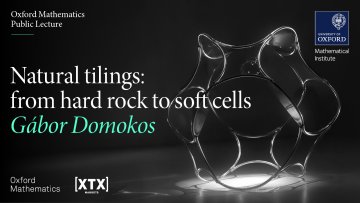15:30
Parametrising complete intersections
Abstract
We use Non-Reductive GIT to construct compactifications of Hilbert schemes of complete intersections. We then study ample line bundles on these compactifications in order to construct moduli spaces of complete intersections for certain degree types.
15:30
Cohomological Donaldson—Thomas invariants for 3-manifolds
Abstract
15:30
On the birational geometry of algebraically integrable foliations
Abstract
I will review recent progress on extending the Minimal Model Program to algebraically integrable foliations, focusing on applications such as the canonical bundle formula and recent results toward the boundedness of Fano foliations.
In this Oxford Mathematics Public Lecture Gábor Domokos uses the geometric theory of tilings to describe natural patterns ranging from nanoscale to planetary scale, appearing in physics, biology, and geology and will introduce a new class of shapes called soft cells, which appear in both living and non-living nature.
Optimal random sampling for approximation with non-orthogonal bases
Abstract
Cubic-quartic regularization models for solving polynomial subproblems in third-order tensor methods
Abstract
High-order tensor methods for solving both convex and nonconvex optimization problems have recently generated significant research interest, due in part to the natural way in which higher derivatives can be incorporated into adaptive regularization frameworks, leading to algorithms with optimal global rates of convergence and local rates that are faster than Newton's method. On each iteration, to find the next solution approximation, these methods require the unconstrained local minimization of a (potentially nonconvex) multivariate polynomial of degree higher than two, constructed using third-order (or higher) derivative information, and regularized by an appropriate power of the change in the iterates. Developing efficient techniques for the solution of such subproblems is currently, an ongoing topic of research, and this talk addresses this question for the case of the third-order tensor subproblem. In particular, we propose the CQR algorithmic framework, for minimizing a nonconvex Cubic multivariate polynomial with Quartic Regularisation, by sequentially minimizing a sequence of local quadratic models that also incorporate both simple cubic and quartic terms.
The role of the cubic term is to crudely approximate local tensor information, while the quartic one provides model regularization and controls progress. We provide necessary and sufficient optimality conditions that fully characterise the global minimizers of these cubic-quartic models. We then turn these conditions into secular equations that can be solved using nonlinear eigenvalue techniques. We show, using our optimality characterisations, that a CQR algorithmic variant has the optimal-order evaluation complexity of $O(\epsilon^{-3/2})$ when applied to minimizing our quartically-regularised cubic subproblem, which can be further improved in special cases. We propose practical CQR variants that judiciously use local tensor information to construct the local cubic-quartic models. We test these variants numerically and observe them to be competitive with ARC and other subproblem solvers on typical instances and even superior on ill-conditioned subproblems with special structure.


